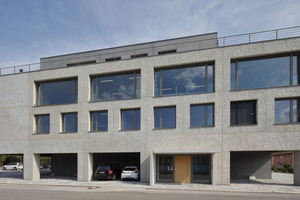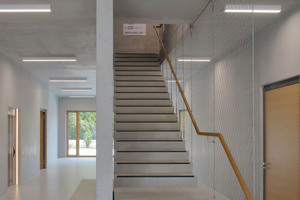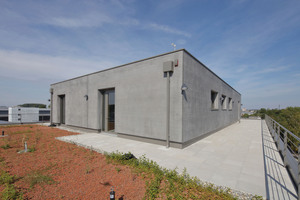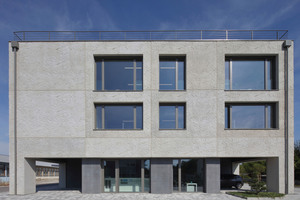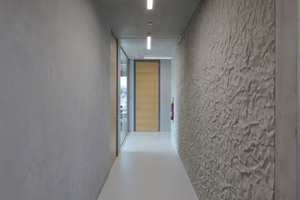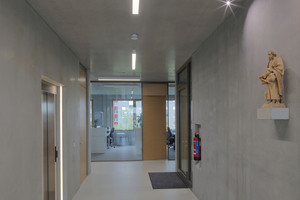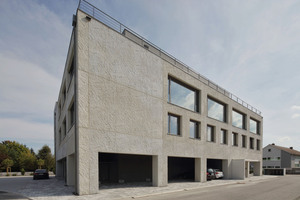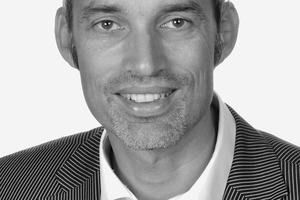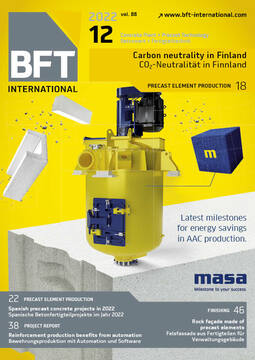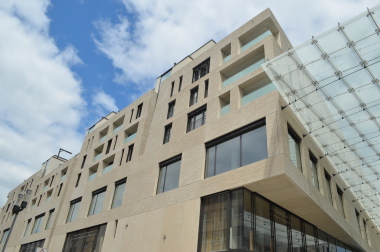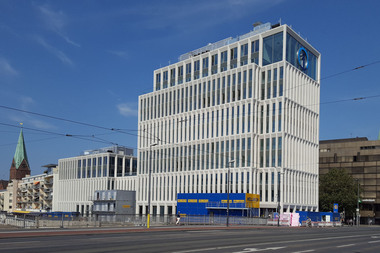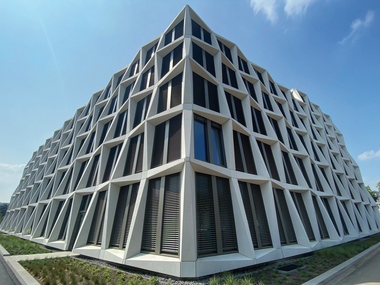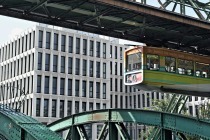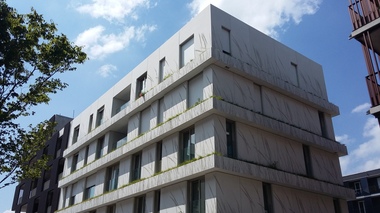Rock façade made of precast elements for the administration building of Zuber-Beton
In Crailsheim in Germany, the company Zuber Beton GmbH has moved into a new administration building. The architectural façade is designed to reflect the possibilities of the precasting plant and its production. The article can also be read, in German only, in the yearbook BetonBauteile Jahrbuch 2023, which will soon be available from Profil-Buchhandlung of Bauverlag.
In Crailsheim in Germany, the company Zuber Beton GmbH has moved into a new administration building. The architectural façade is designed to reflect the possibilities of the precasting plant and its production. At the same time, great importance was attached to an especially pleasant working environment.
The four-story building is characterized by an all-around gallery on the ground floor, consisting of numerous roofed parking pockets. Zuber points out that the building has no basement level, not least for cost reasons, and that the required technical facilities are now located on the ground floor. Due to the all-around parking spaces, the entire ground floor area is also considerably smaller, compared to the two connecting upper stories. With the exception of the goods receiving department, which is oriented toward Rossfelder Street, all office workplaces are therefore located at least one level above the ground floor.
Performance specifications
Prior to design, performance specifications listing the required rooms were developed. It was also specified that the newbuild should have a cubic form. Several planning cycles arrived at the optimal division of rooms. They provided – as mentioned above – that the ground floor was to accommodate only the rooms with the technical facilities and that the first and second upper floors would include all offices. The third floor, with a recessed stepped level and with a large outdoor terrace, will ultimately accommodate a large hall with the required ancillary rooms.
In addition to the enclosed fire-escape stairwell, the building features a third open staircase, which begins on the ground floor as direct extension to the main entrance in the form of a single-flight stairway. This stair is also executed as a precast element and was given sculpture-like character, achieved in particular by a single-step platform. The solution to build a platform had actually been arrived at for practical considerations. It can be used for sitting, but its main purpose is to subtly draw attention to the fact that the clear height is so low that one can easily strike one’s head on the sloping lower edge of the concrete stair. Steel nets were used as railing; they not only appear light and transparent but also emphasize the raw and industrial appearance. However, to avoid the impression of incompleteness, the handrails of the stair were executed in oak.
Showing what is possible
Above the carport gallery, a perforated architectural concrete façade with a relatively high portion of glass has been provided. But there are also a number of completely closed building axes. All the concrete surfaces have a rock-like texture, which has been achieved with textured formliners. In contrast, the wall areas that enclose the carport gallery on the inside feature an austere horizontal rib, the same as the recessed exterior wall of the wall areas of the final third stepped floor. This geometric figure creates a deliberate contrast to the more organic-like rock shapes of the main façade.
The closed wall areas of the office tracts also consist of precast elements, which are likewise provided with a special surface texture. Here, the same as for the external façade, textured formliners were used. The different surfaces are intentional and give customers an idea of the many possibilities for designing concrete. The rocklike architectural concrete surface was executed in white concrete; for the additional elements normal, partly colored, cements were used. But for all concrete elements only non-prestressed steel reinforcement was required.
Structural design
The façade, at the same time, represents the unfinished building structure. It consists of loadbearing concrete sandwich elements that also take up the weight of the individual floor slabs. All the elements have a thickness of 60 cm and are each provided with a mineral-wool insulation of 30 cm thickness with a thermal conductivity coefficient of λ = 0.035 W/(m²K).
The floor slabs are precast with in-situ structural concrete topping. The screed applied to them is designed as a double floor. All installation conduits were laid below here in this highly flexible installation level, which is above the unfinished floor slab. This was necessary because the floor slabs have a heating and cooling function and could not be covered with suspension systems. The office tracts are floored with reversible carpet tiles, which feature acoustic backing to reduce noise. The other interior rooms are dominated by hard surfaces (concrete walls and floors, glass surfaces, office furniture), which was compensated for by the carpet tiles. The floors of the corridors and utility rooms, on the other hand, were provided with jointless epoxy coating.
Thanks to the very short erection time in comparison to the production time, all elements were precast and placed in intermediate storage. Since the elements in the individual floors are repetitive, an optimized production sequence and erection-oriented storage system had been implemented.
Environmentally-oriented HVAC system
The building has two flat roofs: the roof above the second floor is primarily used as roof terrace – as already mentioned – and as a second escape route on the third floor. Its southern part is greened. The roof above the third floor – the stepped floor – features one sky dome above each of the three stairwells. These illuminate the vertical connecting elements and function at the same time as a smoke/heat extraction system (RWA).
The complete remaining area of the uppermost flat roof is occupied by a solar-panel system in east-west orientation with a maximum performance of 30 kilowatt-peak (kWp). Up to approx. 70% of the power generated is used by the building itself, in particular for operating the air heat pump used for heating and/or cooling.
Form follows function
The building, far from being simply a functional building, is in fact a successful synthesis of a user-oriented building and appealing architecture. Additional factors there are construction materials with extremely long service life and prudent use of sustainable technology.
All this taken together makes this building an example of contemporary architecture. Even if this timeless building should someday lose its present purpose, it will surely continue to be used. Its high functional quality is emphasized by an appealing form language: the building practically invites you to step in and use it.
Bautafel:
Auftraggeber: Zuber Beton GmbH
Entwurfsplanung: ABMP, Freiburg/Breisgau
Ausführungsplanung: CN-Projekte GmbH & Co.KG, Crailsheim
Fertigteilplanung: bsp-plan GmbH, Crailsheim
Betonfertigteile: Zuber Beton GmbH

